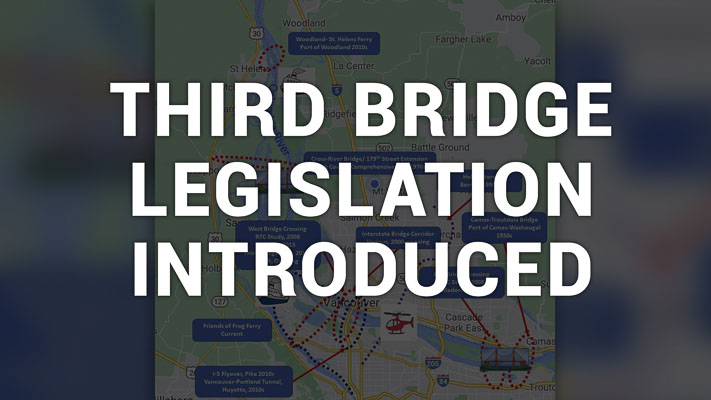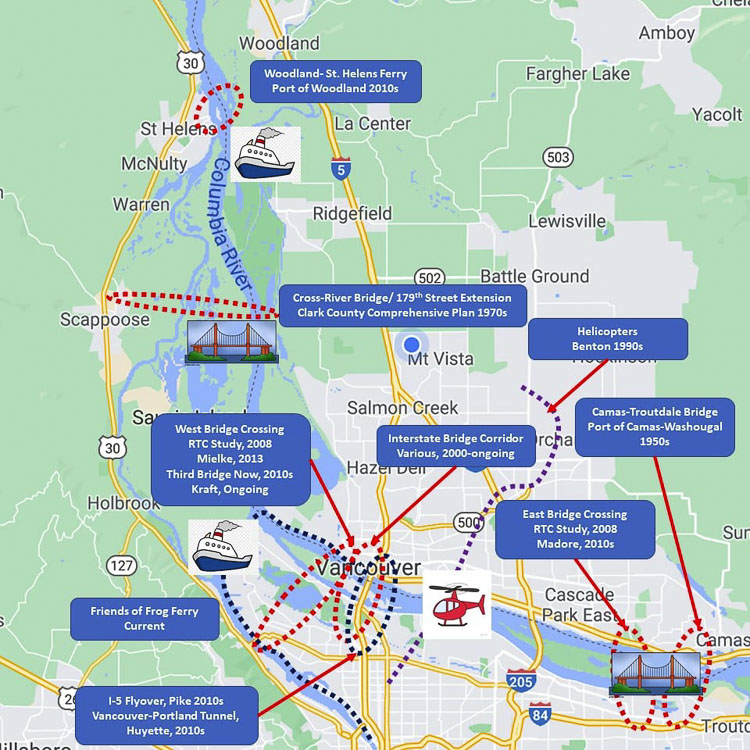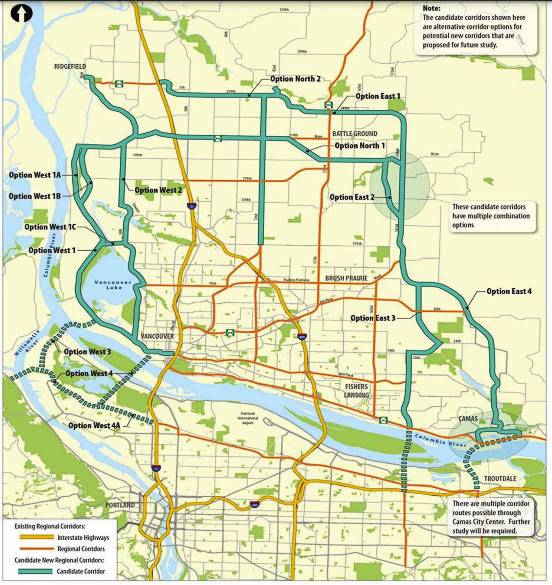
Planning for additional bridge across Columbia River proposed
Legislation has been introduced in the Washington State Legislature to begin the study for a third bridge across the Columbia River. This comes in the midst of intense community discussions regarding the potential expenditure of $3-5 billion to replace the Interstate 5 Bridge.
Two bills have been introduced, as “An act relating to studying the construction of a third bridge over the Columbia river between southwest Washington and Oregon.” House Bill 2034 is sponsored by Representatives Brandon Vick and Larry Hoff (Republicans, 18th District) and Vicki Kraft (Republican 17th District) and Robert Southerland (Republican 39th District). Senate Bill 5934 is sponsored by Senators Lynda Wilson (Republican 17th District), Ann RIvers (Republican 18th District) and John Braun (Republican 20th District).
On Monday, the House Transportation Committee held a public hearing on HB 2034. No citizens testified. Staff shared the bill would provide $300,000 to the Joint Transportation Committee to study “options and strategies” for construction of a third bridge across the Columbia River.

The study must consider
- traffic demand, including general purpose traffic relief that may be afforded to existing highway routes by the creation of a third bridge;
- anticipated freight traffic demand, including freight traffic relief that may be afforded to existing highway routes by the creation of a third bridge;
- a cost-benefit analysis of constructing a third bridge, which must include analysis on the estimated cost to construct a third bridge;
- potential locations for a third bridge across the Columbia River between southwest Washington and Oregon; and
- preliminary design options for a third bridge.
A final report must be submitted to the transportation committees of the legislature by June 30, 2023.
Vick introduced the bill to the House committee. “The I-5 versus third bridge discussion has been a topic of conversation for a long time,” he said. “Today, I’m here in front of you to talk about not if the I-5 bridge or a third bridge; but I’m here to talk about what our future looks like.”
“The bill is intended to look forward,” he said. He went on to mention the progress of the Interstate Bridge Replacement Program (IBR), but said the current program will not solve all of Southwest Washington’s transportation problems. Vick wanted to look 5, 10, or 20 years into the future, knowing the growth of the region will require additional bridges.
“It’s not going to solve some of our underlying problems,” Vick said in reference to the current IBR. “The Portland metro area continues to grow at a rapid rate. (The IBR) is not going to solve the problem that when I-5 or I-205 gets shut down, we’re cut off from the rest of the world.” He specifically mentioned police activity that closed the interstate for 8 to 10 hours recently.
Rep. Keith Goehner (Republican, 12th District) asked what the additional capacity or number of lanes would be. VIck responded, saying he would leave that up to the experts to evaluate the projected needs for vehicles and freight.
Committee Chair Jake Fey (Democrat, 27th District) asked if the third bridge would go to the west of I-5 or not. Vick said he would leave that up to the professionals as well. He mentioned that growth appears to be happening faster to the west of I-5, but a bridge there would likely be more expensive.
Growth to the east of I-205 is constrained by the Columbia River Gorge, but a bridge east of I-205 would connect Camas with Gresham, Vick noted. He implied it would likely be an easier and cheaper third bridge to build at that location.
“It’s going to take a lot of land, it’s going to take a lot of time,” Vick said. “So I think this is step one, figuring out what is possible.”
RTC Board discussion
Matt Ransom, director of the SW Washington Regional Transportation Council (RTC) briefed the Board of Directors on Tuesday about numerous legislative issues, mentioning the Vick-Wilson bills. He spoke with the state transportation committee staff offering to help. He also mentioned our RTC’s creation of the 2008 “Visioning Study” which projected the ultimate need for two new bridges and transportation corridors across the Columbia River.
“I think this is putting the right direction, giving money in the right amount, to the right joint transportation committee to begin earnest planning that we need for a third corridor,” Councilor Gary Medigy said in response to Ransom’s briefing. “I really believe that we should very quickly, get behind it as an RTC, and say we very strongly support this, to see if we can give it a push.”
Near the end of the meeting, RTC Board Chair Shawn Donaghy (CEO C-Tran) added his perspective. He seemed to throw cold water on Medvigy’s suggestion for quickly communicating support for the legislation.
“I would say that while we understand that the priority in our current iteration right now is the I-5 Interstate bridge replacement, I think the RTC does have to take a role at some point of looking at our future crossings and begin to start to take the lead on that,” Donaghy said. “So once we’re in a position that we’re comfortable with the movement of the Interstate bridge replacement, I do think it’s important for us to start to explore what that means long term and how we need to get involved in some of those discussion items.”
Medvigy has been pushing to get the RTC to move forward with studying and planning for a third bridge from his first days as a member of the RTC Board.
At an August 2019 review of the 2008 RTC “Visioning Study,” Medvigy encouraged the RTC to move forward, inviting Oregon’s participation, but to move forward regardless.
“Why didn’t Oregon participate?” Medvigy asked. “And then the second question is, why didn’t RTC, at some point, pass a resolution to kick off some of this planning both north and south of the river?”
“We can’t kid ourselves,” Rep. Vicki Kraft said at the 2019 meeting, “we have to have more crossings. For our commuters, for our freight, our economy. So I believe we do have the power to provide leadership, engage them in this conversation, and now is exactly the time to do it.”
The Clark County Council recently voiced support for a 3rd and 4th bridge corridor planning, in a position paper they sent to the IBR team.
“It was my pleasure to work for what we Clark County residents need, and that is legitimate relief of traffic congestion,” Councilor Karen Bowerman said in an email to CCT last fall. “The planning horizon is long and challenging. But starting now, we will have fewer missteps of allowing the construction of roads and housing and businesses where the new corridors would be.”

The County Council document noted: transportation architect Kevin Peterson scrutinized Columbia River Crossing (CRC) traffic project data which came from two Washington studies between 2000 and 2007. He identified that by 2060, there would be the need for nine lanes in each direction on the I-5 corridor and eight lanes in each direction on the I-205 corridor. That indicates 17 total lanes would be needed across the Columbia River just 40 years from now. There are seven today.
A question for regional planners: Do we want all those vehicles to use only two existing transportation corridors? It would seem to make sense to spread the traffic flow across the river among multiple transportation corridors, each serving the needs of different communities.
Portland has a dozen bridges across the Willamette River, over about a 12-mile area. Each serves different communities, and spreads the transportation burden among many smaller transportation corridors. One can only imagine the traffic nightmare if Portland had only two bridges across the Willamette River.
Additional crossings of the Columbia RIver have been discussed and proposed for over half a century. Chuck Green recently shared a graphic to highlight all the discussions and ideas that have thus far, not borne fruit. This story highlighted those options.
Regional population has doubled since the Glenn Jackson Bridge opened in 1982, connecting east Portland with Clark County. Both I-5 and I-205 bridges are now beyond their design capacity for the number of vehicles they carry.
Citizens should monitor and offer support for HB 2084 and SB 5934,





Finally…. a breath of sanity! Nearly anybody who has an opinion on the bridge mentions their desire for a third bridge.
Having lived in both Clark county as a home owner and now back in Oregon. I understand the need. But what also needs to be addressed is the amount of lanes. You want people to live in each state. However 205 N. Typically thins out over the bridge 4 lanes. The infrastructure needs to address the growing population. They never thought more than 3 lanes we’re needed on 205 in 1982. Oregon born in 1970. Well before 205. The longer traffic is at a standstill, the greater the pollution. Look at the traffic now just trying to merge to SR14 or 84. During rush hour, neither side was well thought out. I-5 is insane. Marine drive backlog and unenforced HOV lanes. This bridge also needs to avoid having to have a bridge lift at all costs. I don’t believe Camas and Gresham is the best route. It will cause more pollution to go that much out of the way. Besides if 84 at Troutdale, is the bridge shut as well. typically shut down during winter Lastly even though l currently reside in Happy Valley. My spouse still works downtown PDX. We both oppose the max line across state lines. Too easy for criminal behavior to be brought North! We left Oregon to get away from the crime. After the last few years, murders, stabbings, plus who wants to sit next to some who smokes. Some people are allergic. The last time we rode the train hypodermic needles were on a seat. Does Clark county want that crossing over
The best and of course most expensive solution is to connect the overall metropolitan freeway “wheel” around the city. The missing section is in the Northwest area. It would connect US 26/sunset hwy @ Plains to I-5 near Salmon Creek. It would cross the Columbia @ Sauvies Island.
This would take 20% of the traffic load off US 26 between Portland and Beaverton, as well as that much off of the I-5.
It is always smarter/cheaper to build it BEFORE it is developed.
It would be nice to have a bridge out of the Camas/Washougal area so we can stay out of the Vancouver mess.